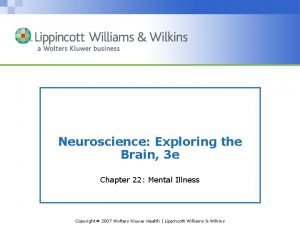Chapter 9 Time Management Copyright 2015 Wolters Kluwer


























- Slides: 26

Chapter 9 Time Management Copyright © 2015 Wolters Kluwer Health | Lippincott Williams & Wilkins

Time Management Is Making Optimal Use of Available Time • Because time is a finite and valuable resource, learning to use it wisely requires both leadership skills and management functions • There is a close relationship between time management and stress • Good time-management skills allow an individual to spend time on things that matter Copyright © 2015 Wolters Kluwer Health | Lippincott Williams & Wilkins

Three Cyclic Steps • Allow time for planning and establishing priorities • Complete the highest priority task whenever possible • Try to finish one task before beginning another • Reprioritize based on remaining tasks and new information that may have been received Copyright © 2015 Wolters Kluwer Health | Lippincott Williams & Wilkins

Reminder • Two mistakes common in planning are underestimating the importance of a daily plan and not allowing adequate time for planning Copyright © 2015 Wolters Kluwer Health | Lippincott Williams & Wilkins

The Smart Approach to Studying • 1. Set specific, clear goals to be accomplished • 2. Record your progress as measurable progress maintains your interest • 3. Identify the steps needed to accomplish your goals • 4. Be realistic about your time constraints and set goals that can be accomplished within these constraints • 5. Set a time frame and plan for this • Adapted from: Pugsley, L. (2009, May). How to… study effectively. Education for Primary Care, 20(3), 195– 197. Copyright © 2015 Wolters Kluwer Health | Lippincott Williams & Wilkins

Creating a Time-Efficient Work Environment • Gather all supplies needed before starting an activity • Group activities that are in the same location • Use time estimates • Document nursing interventions as soon as possible after they are completed • Always strive to end the work day on time Copyright © 2015 Wolters Kluwer Health | Lippincott Williams & Wilkins

Daily Planning Actions to Utilize Time • Identify key priorities to be accomplished that day • Determine the expected level of achievement of a prioritized task • Assess the staff assigned to work with you • Review the short- and long-term plans of the unit • Plan ahead for meetings • Allow time to assess progress of goal attainment • Take regular breaks and use electronic calendars Copyright © 2015 Wolters Kluwer Health | Lippincott Williams & Wilkins

Three Categories of Prioritization • 1. “Don’t do” • 2. “Do later” • 3. “Do now” Copyright © 2015 Wolters Kluwer Health | Lippincott Williams & Wilkins

Three Basic Steps in Time Management 1. Allow time for planning and establish priorities 2. Complete the highest-priority task whenever possible, and finish one task before beginning another 3. Reprioritize based on the remaining tasks and on new information that may have been received Copyright © 2015 Wolters Kluwer Health | Lippincott Williams & Wilkins

Setting Priorities Priority setting is perhaps the most critical skill in good time management, because all actions we take have some type of relative importance Copyright © 2015 Wolters Kluwer Health | Lippincott Williams & Wilkins

Personal Organization—Knowing and Understanding How and Why You Use Time or Set Priorities as You Do • How do you waste time? • What types of work you avoid? • What is the best time of day for you to work? • How long you can work before becoming nonproductive? Copyright © 2015 Wolters Kluwer Health | Lippincott Williams & Wilkins

Managing Time Managing time is difficult if a person is unsure of his or her priorities for time management, including personal short-term, intermediate, and long-term goals Copyright © 2015 Wolters Kluwer Health | Lippincott Williams & Wilkins

Personal Characteristics of Time Wasting • Does not understand time planning • Cannot distinguish what is important from what is not • Underestimates time and effort needed to accomplish tasks • Makes too many rules or procedures or approvals • Anxiety about planning robs energy • Does not look at the standard of work necessary Copyright © 2015 Wolters Kluwer Health | Lippincott Williams & Wilkins

Making Lists • Remember that lists are planning tools and thus must be flexible! • Re-examine items that remain on the list day after day. Perhaps they do not need to be done or they need to be broken down into smaller tasks • Only put as many items on the daily list as can reasonably be accomplished in a day Copyright © 2015 Wolters Kluwer Health | Lippincott Williams & Wilkins

Question Which is a pitfall of list making? A. Being too flexible B. Looking at one’s list too often C. Including an unreasonable number of items on one’s list Copyright © 2015 Wolters Kluwer Health | Lippincott Williams & Wilkins

Answer: Rationale: Copyright © 2015 Wolters Kluwer Health | Lippincott Williams & Wilkins

Internal Time Wasters • 1. Technology (Internet, gaming, e-mail, and social media sites) • 2. Socializing • 3. Paperwork overload • 4. A poor filing system • 5. Interruptions Copyright © 2015 Wolters Kluwer Health | Lippincott Williams & Wilkins

Discouraging Socialization • Do not make yourself overly accessible • Interrupt a rambling person • Avoid promoting socialization • Schedule long-winded pests Copyright © 2015 Wolters Kluwer Health | Lippincott Williams & Wilkins

Procrastination • Putting off something until a future time, postponing, or delaying needlessly • Not a character flaw, but a set of behaviors that develop over a period of time and that can be changed • The dread of doing a task uses more time and energy than doing the task itself Copyright © 2015 Wolters Kluwer Health | Lippincott Williams & Wilkins

Manageable Tasks Some projects are not accomplished because they are not broken down into manageable tasks Copyright © 2015 Wolters Kluwer Health | Lippincott Williams & Wilkins

The Time Inventory • Helps the individual determine how much time he or she spends on a particular task and what time of day he or she is most productive • It is important to maintain the time inventory for several days or even weeks and to repeat it annually to see if long-term changes have been made Copyright © 2015 Wolters Kluwer Health | Lippincott Williams & Wilkins

Personal Time Management • Managing time is difficult if a person is unsure of his or her priorities for time management, including personal short-term, intermediate, and long-term goals Copyright © 2015 Wolters Kluwer Health | Lippincott Williams & Wilkins

Bran’s 12 Habits to Master Time Management 1. Strive to be authentic 2. Favor trusting relationships 3. Maintain lifestyle that gives you maximum energy 4. Organize day by your biorhythms 5. Set very few priorities and stick to them 6. Turn down things inconsistent with your priorities 7. Set aside time for focused effort Copyright © 2015 Wolters Kluwer Health | Lippincott Williams & Wilkins

Bran’s 12 Habits to Master Time Management—(cont. ) 8. Always look for ways of doing thing better and faster 9. Build solid processes 10. Spot trouble ahead and solve problems immediately 11. Break goals into small units of work and think only about one unit at a time 12. Finish what is important and stop doing what is no longer worthwhile Copyright © 2015 Wolters Kluwer Health | Lippincott Williams & Wilkins

Question Tell whether the following statement is true or false: According to Bran, one should master personal time by setting many priorities and sticking to them. A. True B. False Copyright © 2015 Wolters Kluwer Health | Lippincott Williams & Wilkins

Answer: Rationale: Copyright © 2015 Wolters Kluwer Health | Lippincott Williams & Wilkins
 Wolters kluwer health
Wolters kluwer health Lippincott
Lippincott Wolters kluwer
Wolters kluwer Wolters kluwer
Wolters kluwer Shunting inhibition
Shunting inhibition Chemical synapse
Chemical synapse Lippincott williams & wilkins
Lippincott williams & wilkins Exercise physiology for health, fitness, and performance
Exercise physiology for health, fitness, and performance Wolters kluwer
Wolters kluwer Wolters kluwer health
Wolters kluwer health Wolters kluwer health
Wolters kluwer health Wolters kluwer
Wolters kluwer Wolters kluwer health
Wolters kluwer health Wolters kluwer
Wolters kluwer Virchow's triad
Virchow's triad Wolters kluwer pronunciation
Wolters kluwer pronunciation Wolters kluwer
Wolters kluwer Wolters kluwer
Wolters kluwer Wolters kluwer
Wolters kluwer Wolters kluwer
Wolters kluwer Physical examination techniques
Physical examination techniques Wolters kluwer ovid
Wolters kluwer ovid Wolters kluwer health lippincott williams & wilkins
Wolters kluwer health lippincott williams & wilkins Wolters kluwer culture
Wolters kluwer culture Wolters kluwer pronunciation
Wolters kluwer pronunciation Copyright 2015 all rights reserved
Copyright 2015 all rights reserved Copyright © 2015 all rights reserved
Copyright © 2015 all rights reserved

















































